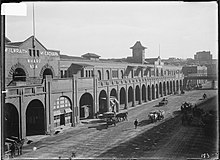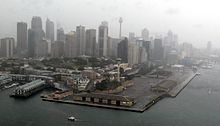
The Hungry Mile is the name harbourside workers gave to the docklands area of Darling Harbour East, in Sydney, New South Wales, Australia in the Great Depression. Workers would walk from wharf to wharf in search of a job, often failing to find one.
The system of day labour gave rise to similar conditions on many port areas, such as Melbourne's Wailing Wall.
As stevedoring operations moved to ports at Port Botany and Port Kembla, the Government of New South Wales determined that this site should be renewed as an extension of the Sydney CBD with a significant new foreshore park providing recreational areas for a growing Sydney population. This area is being redeveloped into a recreational, business and shopping precinct.
The area was officially part of Millers Point. In 2006, as part of the urban renewal plans, the State Government held a competition for the site's name. The Maritime Union of Australia campaigned to renew the "Hungry Mile" name, as an acknowledgement of the site's historical significance to waterside workers. The State Government named the area Barangaroo. The name honours Barangaroo, an important indigenous woman from Sydney's early history who was a powerful and colourful figure in the colonisation of Australia. She was also the wife of Bennelong, another important indigenous figure after whom Bennelong Point is named, the site of the Sydney Opera House. A section of Barangaroo, Hickson Road between the Munn Street overbridge and the Napoleon Street intersection, was officially designated the Hungry Mile in 2009.
Popular culture

In 1930, The Hungry Mile was the title of wharfie poet Ernest Antony's most famous poem, in a published collection titled The Hungry Mile and other poems. Memories of the Hungry Mile and Antony's poem became the inspiration for the Waterside Workers' Federation Film Unit 1950s film of the same name.
References
- "Union leaders walk the Hungry Mile". The Sydney Morning Herald. 4 June 2003.
- "Barangaroo". Sydney Harbour Foreshore Authority. 29 August 2007. Archived from the original on 29 August 2007. Retrieved 30 April 2024.
- "Hungry Mile gets minor role". The Sydney Morning Herald. 12 September 2006.
- "Department of Planning - Media Releases". 16 May 2012. Archived from the original on 16 May 2012. Retrieved 26 June 2020.
- "Barangaroo". Geographical Names Register (GNR) of NSW. Geographical Names Board of New South Wales. Retrieved 4 August 2013.

- "Sydney's Hungry Mile made official". The Sydney Morning Herald. Australian Associated Press. 29 July 2009. Retrieved 23 January 2012.
- "Ernest Antony and the Hungry Mile". Union Songs. 11 April 2008. Retrieved 20 April 2008.
- "The Hungry Mile". Maritime Union of Australia. 15 November 2005. Retrieved 15 September 2006.
- "Department of Planning - Media Releases". 16 May 2012. Archived from the original on 16 May 2012. Retrieved 26 June 2020.
33°51′34.3″S 151°12′4.2″E / 33.859528°S 151.201167°E / -33.859528; 151.201167
Categories: